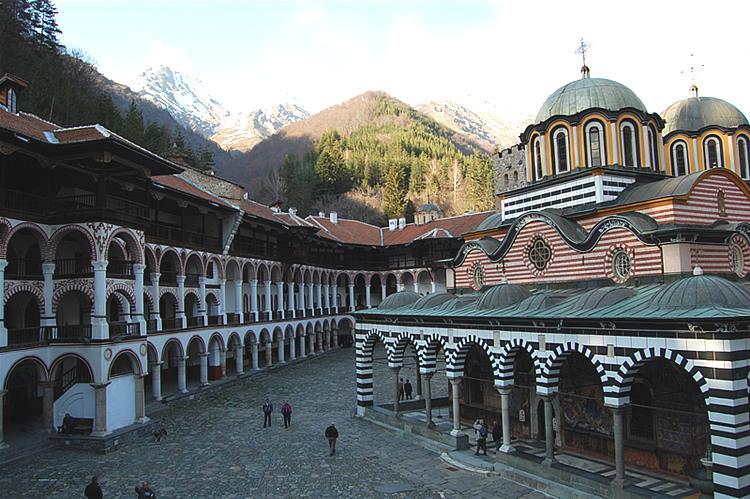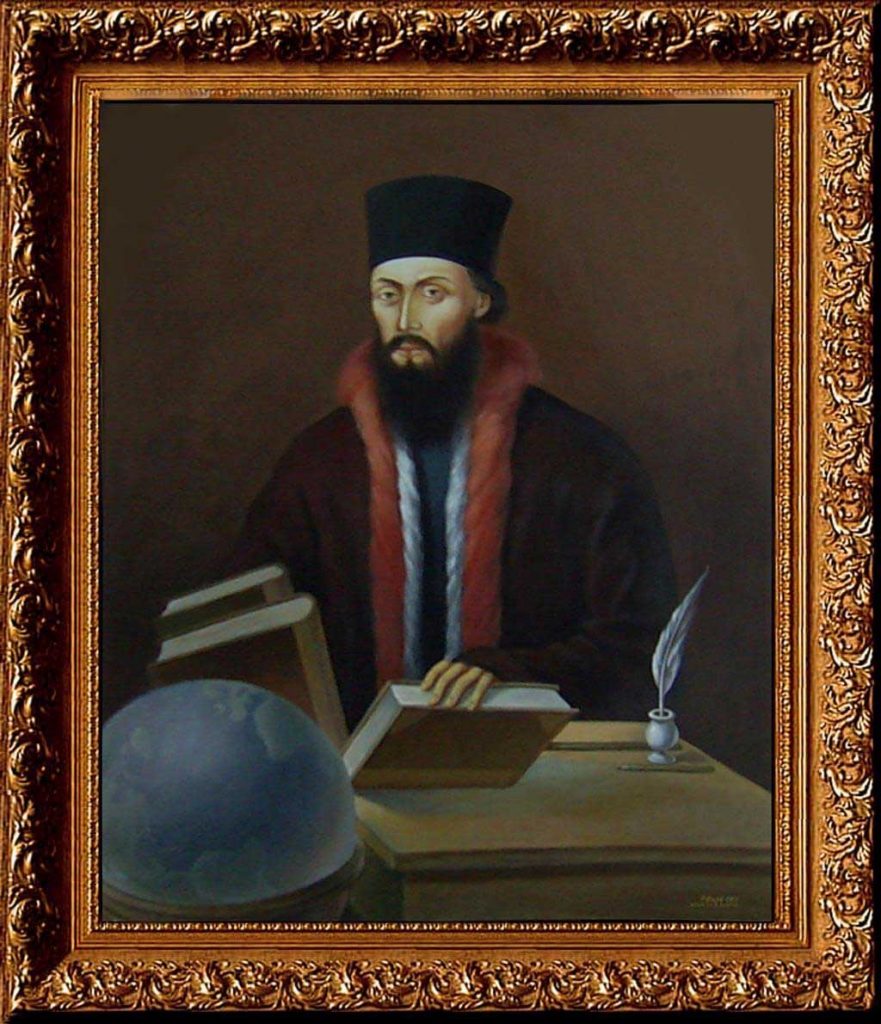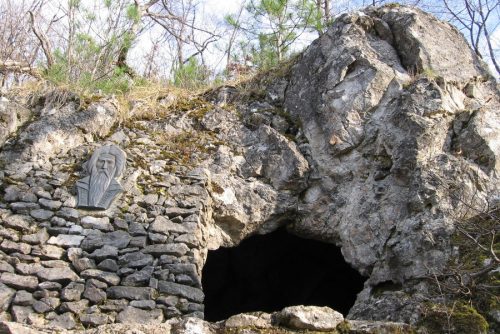Rila Monastery – a Symbol of Bulgarian History
High in the Rila Mountain, where the forest touches the sky and the prayers to God have the greatest power, is the Rila Monastery – one of Bulgaria’s most important cultural, historical, and spiritual must-visits, founded in the 10-th century.
Most likely, you will find it difficult to meet a Bulgarian who hasn’t visited this national heritage at least once in their life. And still – locals and foreigners will be thrilled to hear the story of the Rila monastery complex we’re about to tell in the coming paragraphs.
For better or worse, describing this museum of the Bulgarian soul with words is mission impossible. And yet, we will do our best to introduce you to the history, architecture, and precious arts in and around the Rila Monastery.
History of the Rila Monastery
The legend tells (and historians believe) that the monastery was founded in the 10th century by Saint Ivan Rilski – the first Bulgarian hermit. The monk came to these lands in the first half of the 10th century and devoted himself to a life of hermitage. He spent time in the mountains, fasting and praying, far away from worldly vanity.
The saint found a cave near the place where the present monastery is located, and he spent the last five years of his life in it. After he passed away, his followers built a small stone church near the cave, and that church is still standing there today.
A few months after his death, the relics of Ivan Rilski were collected and moved to the town of Tarnovo. This happened during the reign of tsar Peter in Bulgaria, and most probably thanks to this tsar, Ivan Rilski was canonized as a saint.
In the following years, the relics of Saint Ivan Rilski were moved multiple times until they were finally transferred to the church in the Rila Monastery. Today, everyone can still respect them after arriving on the spot.
But let’s go back to the history of the monastery…
After the death of the hermit, his followers decided to build a monastery near the place where he lived the last years of his life. They chose the current location for two reasons – it was much more secure, and a small temple was already built on the terrain.
The Rila Monastery was erected from 927 to 941. Initially, the cloister was small and quite modest, but in the XIV century, a local feudal called protosebastos Hrelyo Dragovol altered its appearance entirely.
Since the times were already uncertain, Hrelyo transformed the monastery into a well-fortified monastery complex that could withstand attacks.
Under the rule of protosebastos Hrelyo, the monastery complex was enriched with monastic residential buildings, a small one-apse temple, and a defensive tower. Of all the buildings built at that time, only the Hrelyo’s tower is preserved today.
Since its construction, the Rila Monastery was supported by all Bulgarian tsars, who ruled the country until it fell under the Ottoman yoke. Ivan Alexander and Ivan Shishman were among its greatest patrons and contributors. A donation document from 1378 shows that Ivan Shishman donated many lands to the monastery.
All this support quickly turned the monastery into the country’s most important spiritual and cultural center. Unfortunately, its rapid development suddenly halted at the end of the XIV century, when Bulgaria fell under the rule of the Ottoman empire.
In the following centuries, the monastery was attacked multiple times. Until, in the middle of the XV century, this sacred place was destroyed and plundered by the Turkish invaders.
It took many years before the monastery began to revive from the ashes. The first „rays of light” came at the end of the XV century, when with the help of donations and help from Bulgarians from all over the country, the Rila Monastery began to recover as a cultural and spiritual center.
An interesting fact is that Bulgarians weren’t the only ones involved in restoring the sacred place. The Russian and Moldovan Orthodox churches also made donations to the monastery. Their contribution was not limited to money but included books and other church accessories.
The monastery has existed in its currently preserved form since the XIX century. And even if the rest is history, history is remembered and honored.
The architecture of the Rila Monastery
„St. Ivan Rilski” is the biggest monastery in Bulgaria, one of the most visited sights in our country, and one of its most stunning architectural monuments.
The monastery complex is stauropegial and has a unique architecture. Viewed from the outside, its 24-meter-high walls form an irregular pentagon that looks like an impregnable stronghold.
The abbey is located on a total area of 8800 sq. m. and includes residential buildings, a main church, and farm buildings. The premises within the monastery are around 300, and 100 are monastic cells.
From the entrance through the heavy monastery gates, the visitor finds himself in the huge, stone-paved yard of the monument. Then, his attention is immediately drawn to the 24-meter high defensive tower, belonging to the oldest building in the complex.
The Hrelyo’s tower is the oldest building in the monastery, and it’s been left untouched since the sanctuary’s establishment. The tower was built in 1335, and in times of trouble, it has served not only for defense but also as a residential space for the monks.
Most probably, for this reason, the „Transfiguration of the Lord” chapel was built on the top floor of the tower.
Very close to the Hrelyo’s tower and the chapel, you will find the main monastery church, „Nativity of the Blessed Virgin Mary.” The church temple was built by Master Pavel Ivanovich. The construction began in 1834, and it was finished in 1837.
The monastery’s church is a five-domed, cross-dome building with two side chapels. It impresses with its mural paintings and wood-carved iconostases, made by masters from the schools of Bansko and Samokov.
An interesting fact is that although many masters have worked on the frescoes in the church, only Zahari Zograf has signed his mural paintings.
The monastery church preserves:
- the relics of St. Ivan Rilski
- the miraculous icon „Virgin Mary Osenovitca” (XII century)
- the miraculous icon of Saint Ivan Rilski (XVIII century), and many kissing icons from the XIV and XIX centuries.
The monastery buildings are the work of master Aleksey Rilets, who designed the eastern, northern, and western wings. Unfortunately, in 1833 in the Rila Monastery, a fire destroyed the monastic residential buildings, so master Alexey had to build them again.
The genius architect and builder managed to repair the wooden parts of the monastery buildings only for 10 months, and more than 3000 master craftsmen were involved in the restoration process.
Spiritual and scholarly activity in the Monastery
Since its establishment, the Rila Monastery has become the country’s intellectual and cultural center. Behind the monastery walls, Bulgarian scholars of the time wrote books, theological and secular works, and the monks had the role of spiritual leaders.
There was a school in the monastery cloister, where the monks studied not only reading and writing but also higher sciences. The head of the school was a monk called Neofit Rilski, who gave his knowledge to anyone who wanted to learn.
The Rila Monastery also played an important role in preserving the Orthodox Christian faith, which was extremely important work, especially during Ottoman rule.
After the Liberation, the monastery cloister continued being a protector of all oppressed. Its churches gave shelter to numerous figures of the Internal Macedonian-Edirne Revolutionary Organization, such as Dame Gruev, Yane Sandanski, Dobri Daskalov, and others.
In 1976 the Rila Monastery was declared a national historical monument of the country, and since 1983 is in the UNESCO list. In 1992 it passed under the auspices of the Holy Synod of the Bulgarian Orthodox Church. The Ministry of Culture appoints legislative regimes to preserve the site and its buffer zone.
What else can you see in and around the Rila Monastery?
There is much to see, do, and experience when you decide to visit Rila monastery. Except for being one of the holiest places in the whole country, it is also located in a mesmerizing scenery 1,147 m above sea level.
So, here is what to put on your must-see list once you visit the most famous monastery in Bulgaria.
The Monastery Museum
Apart from the main buildings we have already introduced, you can also spend some time seeing the Museum Exposition to the Monastery. Established at the end of the XIX century, the monastery museum preserves valuable models of Bulgarian art from the XIV – XIX century period.
One of the most precious exhibits is a wooden cross with an exquisite carving made by a monk named Rafail. Rafail’s wooden cross is made from a whole piece of wood upon which he recreated 104 religious scenes and 650 miniature figures.
The Magernitsa
„Magernitsa” is the monastery’s kitchen, and in it, you can see the huge cauldrons in which the monks have prepared boiled mutton for the laity during major celebrations.
It dates from 1816, and it was created by one of the greatest Bulgarian builders of the 19th century – master Alexi from Rila.
„Blessed Virgin” church crypt
„Blessed Virgin” is located at the southern end of the monastery complex. The church is built specifically for cemetery rituals, and the bodies of the monks who lived in the monastery are buried around it.
The crypt is situated inside the temple, and the cemetery church was built in three stages, the first one beginning in the XIV century.
The cave of St. Ivan Rilski
The cave where the saint lived for five years and where he found eternal peace is one of the biggest attractions near the Rila Monastery. If you decide to visit it, you must follow the marked 4km trail that will take you there.
In the beginning, we mentioned that the followers of the monk–hermit built a small stone church near the cave itself. Well, this church is still standing there, so you can see it together with the den.
Most probably, the church was built by the monks in the XIV century, but in 1820 it was thoroughly renewed. Through a narrow opening between the rock and the church, you can go into the cave, and according to the beliefs, only a righteous man can go through it.
The legend of Saint Ivan Rilski tells that he was a healer and helped everyone who needed his help. People from all over the country and pilgrims from all over the Balkans still gather around the cave and in the church, hoping St. Ivan Rilski will cure their diseases.
The monastery complex is an active male monastery open to visitors throughout the year.
And others
Other landmarks of local nature and culture you can visit sound the Rila Monastery include:
- The on-site ethnographic museum
- The Seven Rila Lakes
- The valley of the Rilska River
- Skakavitsa waterfall
- Kazanite falls
- Stapalata scenic walk
- The Sapareva Banya mineral pools
- Baikusheva mura, etc.
All you need to do is map the location of your accommodation as a starting point and begin exploring the magic of Rila. Plenty of pictures and videos online will help you design your trip – but none of them will look half as enchanting as the actual places feel.
Practical information about your visit
Before you start exploring the chapels, the tower, the art, and the relics of the monastery, you will first have to take care of the basics.
There is a parking lot in front of the monastery gates, so you can safely leave your car without doing an extended parking spot search. There are enough souvenir shops around the site where you can buy something to remember, but we recommend you to view first the souvenir shop of the monastery.
There you will find a great variety of souvenirs to take home as a memory of this sacred Bulgarian place.
If you would like to stay for the night, the Rila Monastery offers accommodation and food. The site is about two hours away from Sofia, and the road there is smooth and easy.
And yes, we almost forgot! The monastery cloister is famous for making the best mekitsa (fried dough) in the world and offering unique buffalo milk.



